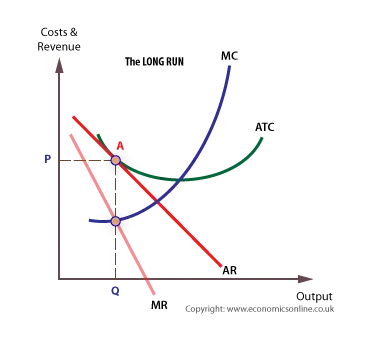
Monopolistic competition
Monopolistic competition
The model of monopolistic competition describes a common market structure in which firms have many competitors, but each one sells a slightly different product.
 |
Monopolistic competition as a market structure was first identified in the 1930s by American economist Edward Chamberlin, and English economist Joan Robinson. |
Many small businesses operate under conditions of monopolistic competition, including independently owned and operated high-street stores and restaurants. In the case of restaurants, each one offers something different and possesses an element of uniqueness, but all are essentially competing for the same customers.
Characteristics
Monopolistically competitive markets exhibit the following characteristics:
- Each firm makes independent decisions about price and output, based on its product, its market, and its costs of production.
- Knowledge is widely spread between participants, but it is unlikely to be perfect. For example, diners can review all the menus available from restaurants in a town, before they make their choice. Once inside the restaurant, they can view the menu again, before ordering. However, they cannot fully appreciate the restaurant or the meal until after they have dined.
- The entrepreneur has a more significant role than in firms that are perfectly competitive because of the increased risks associated with decision making.
- There is freedom to enter or leave the market, as there are no major barriers to entry or exit.
- A central feature of monopolistic competition is that products are differentiated. There are four main types of differentiation:Physical product differentiation, where firms use size, design, colour, shape, performance, and features to make their products different. For example, consumer electronics can easily be physically differentiated.Marketing differentiation, where firms try to differentiate their product by distinctive packaging and other promotional techniques. For example, breakfast cereals can easily be differentiated through packaging.Human capital differentiation, where the firm creates differences through the skill of its employees, the level of training received, distinctive uniforms, and so on.
Differentiation through distribution, including distribution via mail order or through internet shopping, such as Amazon.com, which differentiates itself from traditional bookstores by selling online.
- Firms are price makers and are faced with a downward sloping demand curve. Because each firm makes a unique product, it can charge a higher or lower price than its rivals. The firm can set its own price and does not have to ‘take’ it from the industry as a whole, though the industry price may be a guideline, or becomes a constraint. This also means that the demand curve will slope downwards.
- Firms operating under monopolistic competition usually have to engage in advertising. Firms are often in fierce competition with other (local) firms offering a similar product or service, and may need to advertise on a local basis, to let customers know their differences. Common methods of advertising for these firms are through local press and radio, local cinema, posters, leaflets and special promotions.
- Monopolistically competitive firms are assumed to be profit maximisers because firms tend to be small with entrepreneurs actively involved in managing the business.
- There are usually a large numbers of independent firms competing in the market.
Equilibrium under monopolistic competition
In the short run supernormal profits are possible, but in the long run new firms are attracted into the industry, because of low barriers to entry, good knowledge and an opportunity to differentiate.
Monopolistic competition in the short run
At profit maximisation, MC = MR, and output is Q and price P. Given that price (AR) is above ATC at Q, supernormal profits are possible (area PABC).

As new firms enter the market, demand for the existing firm’s products becomes more elastic and the demand curve shifts to the left, driving down price. Eventually, all super-normal profits are eroded away.
Monopolistic competition in the long run
Super-normal profits attract in new entrants, which shifts the demand curve for existing firm to the left. New entrants continue until only normal profit is available. At this point, firms have reached their long run equilibrium.

Clearly, the firm benefits most when it is in its short run and will try to stay in the short run by innovating, and further product differentiation.
Examples of monopolistic competition
Examples of monopolistic competition can be found in every high street.
Monopolistically competitive firms are most common in industries where differentiation is possible, such as:
- The restaurant business
- Hotels and pubs
- General specialist retailing
- Consumer services, such as hairdressing
The survival of small firms
The existence of monopolistic competition partly explains the survival of small firms in modern economies. The majority of small firms in the real world operate in markets that could be said to be monopolistically competitive.
Evaluation
The advantages of monopolistic competition
Monopolistic competition can bring the following advantages:
- There are no significant barriers to entry; therefore markets are relatively contestable.
- Differentiation creates diversity, choice and utility. For example, a typical high street in any town will have a number of different restaurants from which to choose.
- The market is more efficient than monopoly but less efficient than perfect competition – less allocatively and less productively efficient. However, they may be dynamically efficient, innovative in terms of new production processes or new products. For example, retailers often constantly have to develop new ways to attract and retain local custom.
The disadvantages of monopolistic competition
There are several potential disadvantages associated with monopolistic competition, including:
- Some differentiation does not create utility but generates unnecessary waste, such as excess packaging. Advertising may also be considered wasteful, though most is informative rather than persuasive.
- As the diagram illustrates, assuming profit maximisation, there is allocative inefficiency in both the long and short run. This is because price is above marginal cost in both cases. In the long run the firm is less allocatively inefficient, but it is still inefficient.
Inefficiency
The firm is allocatively and productively inefficient in both the long and short run.

There is a tendency for excess capacity because firms can never fully exploit their fixed factors because mass production is difficult. This means they are productively inefficient in both the long and short run. However, this is may be outweighed by the advantages of diversity and choice.
As an economic model of competition, monopolistic competition is more realistic than perfect competition – many familiar and commonplace markets have many of the characteristics of this model.


